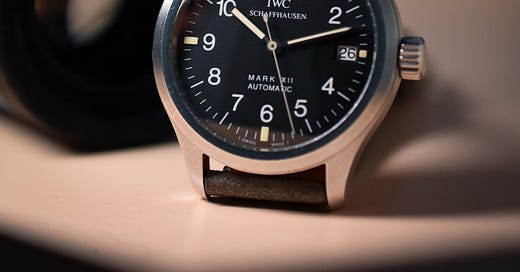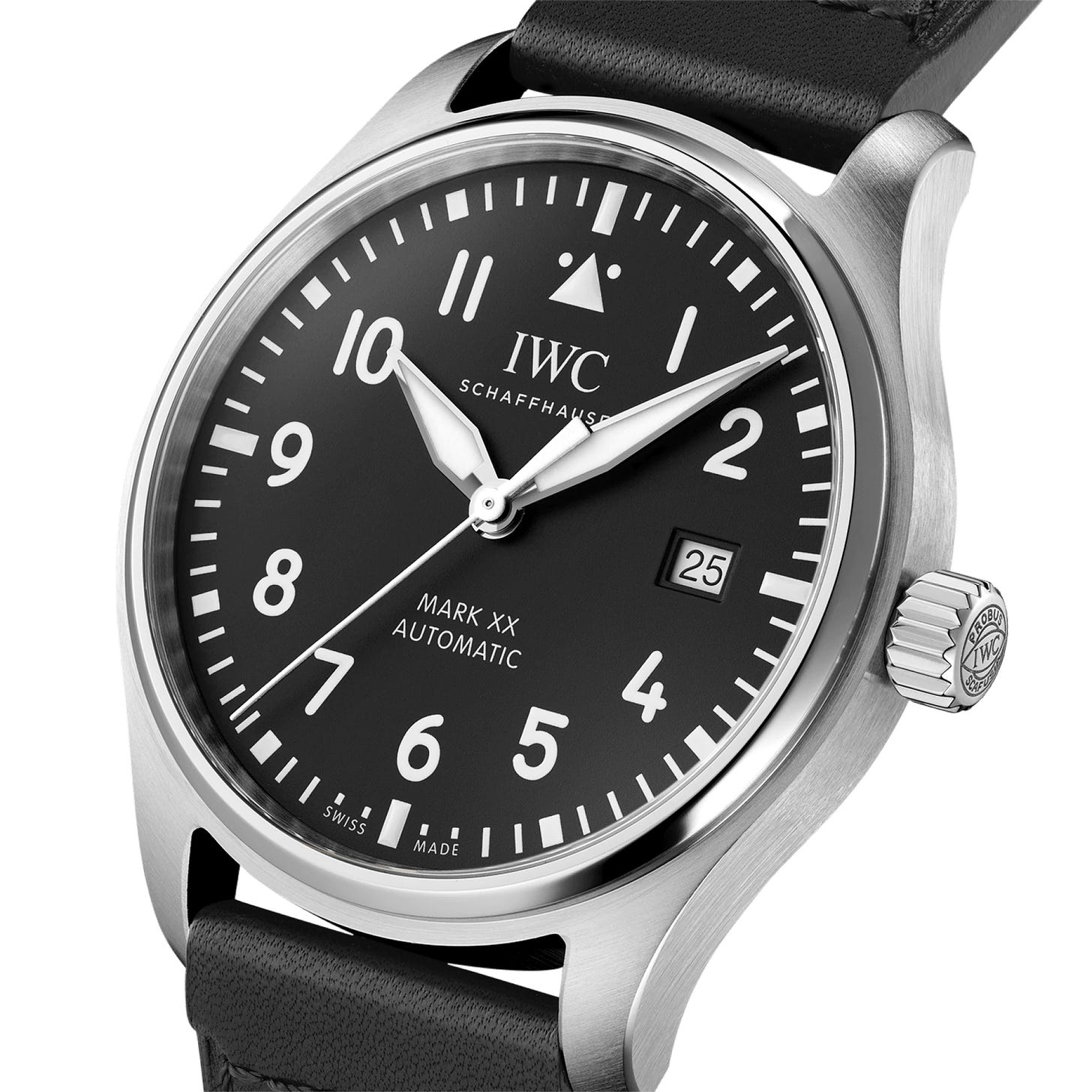I know I said no newsletter for a while, but because I’m totally addicted to watches here’s another one. This isn’t really a full-fledged issue, but more of an:
Odds and ends with those good reads, links, and listens;
A look back at some of Rescapement’s best articles from the first 7 months of the year (kind of like The Best of Shaquille O’Neal, a greatest hits album that no one needed or asked for); and
A shameless opportunity to plug Episode 20 of our podcast Significant Watches, where we talk Tudor Ranger (and vintage Ranger!), and other new releases
Of course, thank you for subscribing. The newsletter has grown to almost 10k strong, and it’s exciting that I’ve had sponsors for most issues this year. Back again soon.
✈️ Marking the Time
Apparently, IWC quietly put a new Mark XX on its website. It’s the latest update to the Mark series, with IWC seemingly skipping XIX from the current XVIII (released in 2016) — putting it on par with the jump from the iPhone 8 to the iPhone X as revolutions so groundbreaking that going up just one digit wasn’t enough.
The 40mm pilot/field watch has a few subtle aesthetic changes, but the biggest one is under the hood, where it’s now got a ValFleurier-produced (Richemont’s own movement manufacturer) caliber with 120 hours of power reserve.
Anyway, I did my whole “would better in 36mm” thing with the Tudor Ranger release a couple of weeks ago so won’t do it again here. Speaking of: The new Ranger costs $3,050 on a bracelet while this new Mark XX runs $5,250 and is only offered on a strap (for now) — that’s tough competition for the International Watch Company.
And this is from someone who loves IWC and the Mark series. I bought a Mark XII from the 90s towards the end of 2021 and it’s been my most worn watch since.
In fact, with the Mark series now topical again, I’d like to do an in-depth story on the whole collection, starting with the WWII-era Mark X. The designs, the calibers, the history — there’s a lot there.
In the meantime, earlier this year I wrote about why I’m so into 90s IWC right now:
I’ve got a long history with IWC. The Portugieser Chronograph was perhaps the first watch I ever noticed. Like, distracted-during-my-first-post-college-job-interview noticed. It didn’t look like the Timexes or Fossils I’d seen growing up, or the gaudy Rollies and Pashas I’d seen jangling on the wrists of my favorite musicians.
The clean white dial, slim bezel, and simple applied Arabic numerals caught the fluorescent light and made it dance in ways I didn’t realize fluorescent light could — and those two big subdials, what were those even for?
I started digging into the brand’s history. Naturally, this leads one through IWC’s heritage as a maker of military and pilot’s watches, the Mark series, and whether there’s a fit brand ambassador Lewis Hamilton can’t pull off.
Quickly, I started to stumble through 1990s IWC watches and their ad campaigns. Dutiful and woke millennial I am, I began to feel reflexively triggered by some of the taglines, retreating to ponder the societal effects of taglines like “IWC. Official supplier of men.” and “Equality of the sexes has to stop somewhere.”
But let’s stick to watches. Advertising aside, IWC’s watchmaking absolutely thrived in the 1990s.
Back then, many luxury watch brands were going, well, luxury. At Rolex, this meant revamping its tool watches into true luxury products: brighter lume, stronger crystals, glossier dials, and heftier cases and bracelets.
On the ad side, Rolex was trying to sell customers on the idea that “At Rolex, steel is a precious metal.”
But IWC asked “who said we want a precious watch?” An IWC is for those who “prefer to dive for their oyster and lobster,” “ride Harleys,” and had other such “typical male characteristics” (all 90s IWC ad taglines). In those days, IWC felt like the cool, anti-Rolex.
In the 1990s, IWC introduced the Mark XII as its upgrade to the classic Mark XI. It still features many of the hallmarks of the Mark XI: classic 36mm case, matte black dial with tritium lume, legible Arabic numerals, and that distinct “clipped” hour hand. It even features a JLC 889/2 caliber, a movemen that’s probably too good for an “entry-level” watch.
This era of IWC is also often referred to as the “pre-Richemont” era. No shade to Richemont — we stan multi-national luxury conglomerates all the time here — but there’s something charming about an independent watch company doing its own thing.
So sure, the new IWC Mark XX looks nice — but for now, I’m a 90s b*tch.
NEW THINGS
🧮 Debunking the Quartz Crisis (EuropaStar)
If you’re interested in business, this is a must-read. The title says it all, painting a picture of a “Quartz Crisis” that was driven more by global and macroeconomic factors than a little quartz oscillator:
“The distinction between vintage and modern is often drawn at the beginning of the 1980s, when nearly every Swiss watchmaking company failed. Although widely called the quartz crisis today, this transition was driven more by the changing global economy than quartz technology.
It seems logical that a new technology like electronic quartz movements would be disruptive to the industry. But the actual crisis that shook the industry was economic, triggered by a rapid increase in value for the Swiss franc but actually caused by the hopelessly-fragmented industry legally restricted from modernisation. Although Japanese and American suppliers of quartz watches made this economic crisis worse, technology was not the driving force. And many high-end manufacturers survived the crisis, laying the foundation for the modern luxury watch industry.”
🚀 How the Secret ‘Project Galileo’ Gave Rise to the MoonSwatch (Wired)
This Wired feature has it all: the hype, the production & development, the interview with CEO Nicolas Hayek, the explanation for those blue wrist stains:
“Even if it wanted to, Swatch does not have the capacity to serve the inevitable frenzied online demand for MoonSwatch. Indeed, Hayek states that the machines are running at full capacity, 24 hours a day, just to try and meet the demand in the brand's 110 bricks and mortar locations. ‘Regardless, our aim is not to hurriedly throw out millions of MoonSwatches into the market and build three times more factories instantly, which you cannot do anyway. The MoonSwatch isn't about making as much money as possible in the shortest possible time period.’”
It’s a fascinating look at production inside one of the world’s largest watchmakers, and perhaps even offers a moment of perspective from Hayek at the end:
“In the postpandemic consumer landscape, Hayek reckons, patience has become a vastly underrated virtue. “‘If the world is serious about sustainability, you cannot make everything available to everybody instantly and comfortably, with a click. This world thinks everything is a commodity, but the MoonSwatch is not a commodity. This is about innovation, beauty, fun, and positive provocation. And last but not least, Swiss made.’
👠 Online watch auctions go deeper into luxury territory. Statistics and perspective from the big auction houses plus new players like A Collected Man and Loupe This (NY Times):
[Sam Hines, who recently joined Loupe This from Sotheby’s] may be biased, but he has a different view: “In five years’ time, the live auction will offer 100 great vintage watches and will be like the Wimbledon tennis tournament,” he wrote. “Is it best to play on grass with a very small audience? No.
“However, it is a very prestigious event that everyone loves. It will never disappear — however, all other tournaments have much faster games with much greater audiences.”
💡 The New York Times also featured Korean watchmaker Minhoon Yoo: In Seoul, Watchmaking with Subtlety
🕰️ CNN says you should start using a classic alarm clock again. Now, someone tell them about travel clocks!
🎧 LISTENS
💼 Business Breakdowns Podcast: Rolex (Feat. Ben Clymer). A favorite podcast of mine covering one of my favorite subjects.
🐧 Watchmaker and historian Dr. Rebecca Struthers made an appearance on BBC Radio.
🏀 JJ Redick chats a bit about how he’s fallen in and out of love with watches in his interview with Throwing Fits.
ICYMI
Now for the “greatest hits” portion of today’s ‘sletter. Here are some binge-worthy pieces from Rescapement: hands-on reviews, in-depth articles, and essays.
HANDS-ON
Rescapement’s gone hands-on with new watches a few times this year:
Not new, but perhaps the coolest watch I’ve held this year: Hands-on with Michael Collins’ Omega Speedmaster
IN-DEPTH
An article about the original Chopard L.U.C. and its caliber 1.96 is the most in-depth piece I’ve written this year, and since the Tudor Ranger has been in the news, here’s my article about the vintage Ranger from a couple of years ago:
I was recently able to buy one of these Chopards from the family of the original owner, so perhaps I’ll do a follow-up with my hands-on impressions soon.
ESSAYS
Some of our favorite essays and more thoughtful provocations:
The Digital Death of Watch Collecting (more optimistic than the title sounds)
‘Cover Watches’ and Accessibility of Ideas in the Watch World (guest post)
Finally, and I had to swallow my pride on this one, one of the most popular posts of the year so far was a simple link I posted: This is the Coolest Explainer on How a Mechanical Watch Works I’ve Ever Seen.






